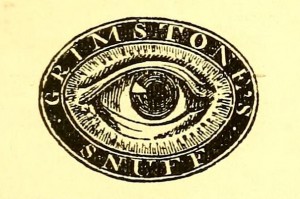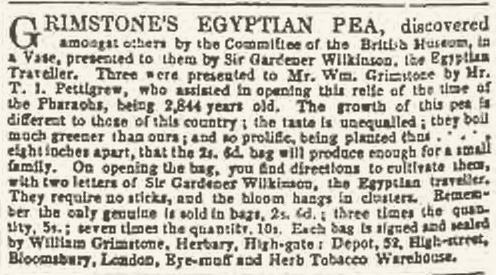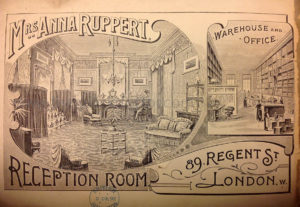 In a Highgate garden known as the Herbary grew plants destined to invigorate nostrils all over the world. Savory, rosemary and lavender scented the air, while orris-root thrived under the carefully cultivated soil. Dried, powdered and mixed with salt, they would become Grimstone’s Eye Snuff, promising to cure cataracts, eradicate the need for spectacles and render the breath impervious to contagion. Sharing these plants’ London home were the ingredients for Grimstone’s Aromatic Regenerator, whose herbal powers would cultivate moustachios and simultaneously ensure freedom from headaches and faintness.
In a Highgate garden known as the Herbary grew plants destined to invigorate nostrils all over the world. Savory, rosemary and lavender scented the air, while orris-root thrived under the carefully cultivated soil. Dried, powdered and mixed with salt, they would become Grimstone’s Eye Snuff, promising to cure cataracts, eradicate the need for spectacles and render the breath impervious to contagion. Sharing these plants’ London home were the ingredients for Grimstone’s Aromatic Regenerator, whose herbal powers would cultivate moustachios and simultaneously ensure freedom from headaches and faintness.
In 1844, however, the Herbary became the site of an even more miraculous regeneration – the supposed resurrection of a plant that had lain dormant for millennia in an Ancient Egyptian tomb.
William Grimstone, the Herbary’s owner, related that during the 1830s, the Egyptologist Sir John Gardner Wilkinson had brought a hermetically sealed ancient vase to the British Museum. There, it was examined by Thomas J Pettigrew, a surgeon and antiquarian whose 1834 book, The History of Egyptian Mummies, had contributed to the prevailing fascination with all things Egyptian and led to him gaining renown for his mummy-unrolling lectures. Pettigrew attempted to open the vase and, ‘unfortunately broke it into several pieces.’
‘The interior,’ reported the London German Gazette, looking back on events from 1849, ‘contained a mass of vegetable dust, with a few grains of wheat and vetches; he was, however, amply indemnified for the destruction of the vase by discovering in this dust a certain number of peas, entirely shrivelled.’
Early attempts at germination failed, and it was only after Pettigrew had passed the last three peas on to Grimstone in 1844 that the latter’s gardening expertise enabled one of them to sprout. The plant produced nineteen pods with sixty small, imperfectly developed grains, and the next year these produced a successful crop. After that, Grimstone was well away, promoting ‘Grimstone’s Egyptian Pea’ as a high-yielding variety with added Pharaonic mystery.
The story was not actually that unusual; ‘mummy wheat’ was already a thing. A famous example that germinated in 1840 in the garden of the poet Martin Farquhar Tupper appears to have come from the same vase as the peas, and the attractive idea of the revival of ancient life has persisted among some gardeners ever since.
In 1849, the mummy pea attracted renewed attention when Dr William (or Wilhelm) Plate of the Syro-Egyptian Society gave a lecture on it. By August of that year, however, newspapers were reporting that the phenomenon wasn’t all it was cracked up to be:
…it is a slow grower—extremely shy in bearing—has a common field-pea appearance—nothing to boast of in quality, and has been pronounced by all who have been duped into its purchase as being nothing more or less than a piece of mere humbug! (Morning Post, 6 August 1849).
The Horticultural Society of London was also sceptical and grew a sample of mummy peas alongside a modern variety, the Dwarf Branching Marrow Pea:
With every advantage of comparison thus afforded by the proximity of the plants, no difference could be observed between Grimstone’s Egyptian Pea and the Dwarf Branching Marrow. The growth of the plants, their foliage, flowers, pods, and seeds exhibited precisely the same characteristics. (Journal of the Horticultural Society of London, vol IV, 1849)
The likelihood was either that Grimstone and his gardeners were deliberately faking, or that the seed samples had at some point been mixed up with newer peas. In 2002, the results of investigations at Kew Gardens were published in the New Scientist, concluding that it is not possible for such ancient seeds to germinate.
In 1850, William Grimstone was declared bankrupt owing to the numerous prosecutions brought against him for selling Eye Snuff without paying tobacco duty (his understandable reason for not doing so was that the product did not contain tobacco). Could it be that this bad luck points to…
THE CURSE OF THE MUMMY PEA! DUN DUN DUUUUUN!!
Then again, he soon got discharged from the debtor’s court, kept possession of the Herbary and carried on selling Egyptian Peas, Eye Snuff, Aromatic Regenerator &c. So if a curse existed, it was a fairly underwhelming one.




25 thoughts on “Mr Grimstone and the Revitalised Mummy Pea”
Comments are closed.